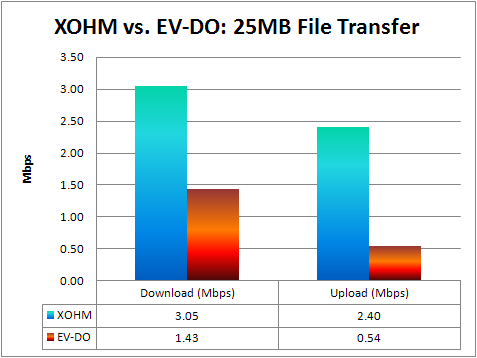XOHM WiMAX In Baltimore: Speed Tests With XOHM ExpressCard

We went to Baltimore today to check out America's first fully-functional XOHM city for ourselves. Earlier today, we had a hands-on experience with XOHM using a Nokia N810 WiMAX tablet. Since then, we've gone out and purchased an ExpressCard adapter, installed it, and have run a bunch of tests in comparison to a Kyocera EV-DO card on Verizon Wireless' network.
Unless otherwise noted, our tests were conducted from a Starbucks on Charles St. in Baltimore, where the signal for both carriers was strong. Our test notebook for the day was a Sony VAIO VGN-Z591U.
Installation
XOHM installs just like a regular ExpressCard mobile broadband unit does. You simply plug it into the side of your notebook and install the driver software. Once you launch the XOHM Connection Manager, it will search automatically for the XOHM network, and if there is one available, you simply need to connect and then log in at the XOHM portal site.
From the XOHM portal site, we were free to search the Web. You can also connect to Wi-Fi networks using the XOHM connection manager if there isn't a XOHM network available. We also love that whenever you plug the ExpressCard unit in, XOHM automatically connects.
Check out our results where we compare XOHM to EV-DO below.
Web Pages / Downloads
We tried visiting the home pages of several popular Web sites using both our XOHM card and a Verizon EV-DO connection and timed the results. We also installed iTunes and downloaded a 233.3MB video of MTV's Rob and Big.
Stay in the know with Laptop Mag
Get our in-depth reviews, helpful tips, great deals, and the biggest news stories delivered to your inbox.
| Web Page / Download | XOHM WiMax Time | Verizon EV-DO Time |
| Nickjr.com | 0:15 | 0:50 |
| CNN.com | 0:14 | 0:28 |
| NYT.com | 0:21 | 0:36 |
| Laptopmag.com | 0:12 | 0:19 |
| 233.3MB iTunes Video | 6:10 | 24:00 |
For some reason, neither network delivered great Web surfing times from our Starbucks location. However, if you look at the difference carriers, XOHM WiMax just plain blew away Verizon EV-DO. To be fair, the EV-DO speeds we experienced were significantly slower than what we normally see at home in New York and we're betting XOHM was also slower in that location than it should have been. But if we just look at the differential, we're talking about a speed increase with XOHM of 50 to 300%, depending on the page.
[flq:2e119444d4a3425abf36d0b5504265ab]
Hulu
We tried watching a video on Hulu.com with both mobile broadband services. On Verizon EV-DO, which actually has a policy against using their service to watch video, it took 13 seconds before our video began playing and the video paused twice in the first minute to rebuffer. It would have continued to rebuffer if we kept watching. On XOHM, we saw a little jerkiness but the video started after just 9 seconds and never paused to rebuffer.
World of Warcraft
In our gaming tests with World of Warcraft, the difference between the Verzion and XOHM services was indistinguishable: we didn't see much lag at all from either network and both delivered an identical 49 frames per second. Perhaps Warcraft is not that bandwidth intensive.
[flq:ea65dcc1d06a4307be8f6734943e249f]
File Transfer Test
For our file transfer test, we downloaded a 25MB MP4 video file from our FTP server and then uploaded it again using Filezilla. XOHM excelled, smashing the 0.75Mbps speed of EV-DO by uploading the same file at a quick 2.4Mbps pace. XOHM also excelled in download speed by returning 3.05Mbps to EV-DO's 1.43MBps. This is great for video editors who want to get clips online quickly.

Skype
We were able to Skype just fine as long as we kept our video in a windowed mode and not full screen. Once we bumped it up to full screen the video was a bit choppier, our caller's voice dropped for a few seconds, and voice audio was out of sync with the video most of the time. However, as you'll see in our windowed chat, voices came through well and movements were, for the most part, fluid.
[flq:470a574e9f834de69c7da1b605ae0851]
Coverage & Pricing
The worst part about XOHM is its coverage right now. Baltimore is the only city you can use the service in today. It will spread to Chicago and Washington D.C. next. Following that, there are plans for XOHM to expand into Dallas, Forth Worth, Boston, Providence, and Philadelphia. Large cities like New York and Los Angeles remain off of the radar, which is frustrating. At least here in Baltimore we never found the edge of the XOHM coverage area.
XOHM costs $10 for a day pass, or $25 per month for Home Internet service and a $30 monthly On-the-go service. There's also the option of a $50 “Pick 2 for Life” monthly service plan. EV-DO on Verizon Wireless, by comparison, costs a sky high $39.99 for just 50MB of data usage or $59.99 for 5GB of data. Additionally, you need to have a 2-year contract. However, this option remains the most attractive for travelers because of Verizon Wireless' extensive nationwide 3G network that's available to 256 million people-- not just the population of a single city. Like Verizon, Sprint and AT&T have fairly broad mobile broadband footprints, with pricing in the same ballpark.
Stability
During our entire day of testing XOHM, we didn't lose a connection while we were stationary. We were able to test inside Baltimore's train station, as well as inside a few eateries downtown.
In a moving vehicle
InfoWorld reported that Clearwire's mobile WiMAX solution in Reno didn't work in cars, so we got in a taxi and asked the driver to take us for a joy ride while we did some more testing on video. We were able to play World of Warcraft just fine, browse the Web, and even begin streaming Hulu videos. We did notice that while uploading video, we averaged about 1.2Mbps, which is half as fast as it was when we were stationary. Furthermore, we dropped a XOHM connection during one part of our trip. However, we were quickly able to reconnect as we continued to move, so we still hadn't reached the edge of the coverage.
[flq:5a10947654744f46be77fce00bb77b16]
Of course, EV-DO is capable of this, too. Last Friday I took a bus ride from New York City to the Lehigh Valley in Pennsylvania and streamed the presidential debate live. While I ran into plenty of dead spots and had some lag, the experience was still enjoyable and worthwhile. XOHM doesn't cover these great distances yet, so again, travelers will want to stick to EV-DO for now.
Final Thoughts
So far we love XOHM. The file transfer speeds are far superior to 3G, and we are big fans of the option to subscribe for just a day, or share it across multiple devices.
We used the same account that we signed up with using our Nokia N810 this morning on our notebook, without having to tell XOHM that we switched devices. That means your buddy with a XOHM card can quickly log on using your account when you're not setup, totally eliminating useless monthly fees for the few days that you or a family member wants mobile broadband access.
The biggest bummer is that XOHM is only available in Baltimore right now. Is it worth it when it comes to your city? Absolutely, the monthly charges are less and you aren't bound to a contract. If you're a traveler, though, you may want to hang on to the multi-band options that allow EV-DO or HSDPA connectivity as well as XOHM options.
